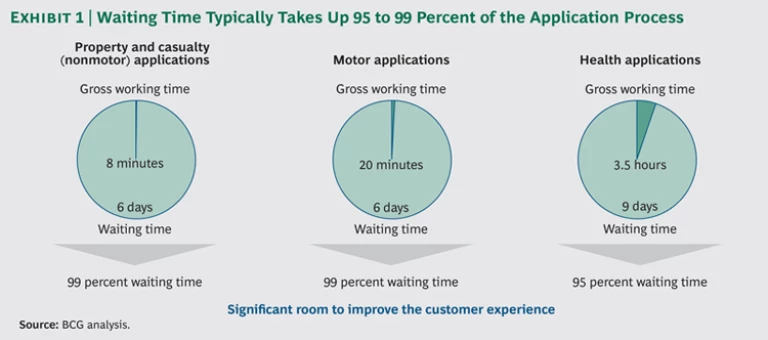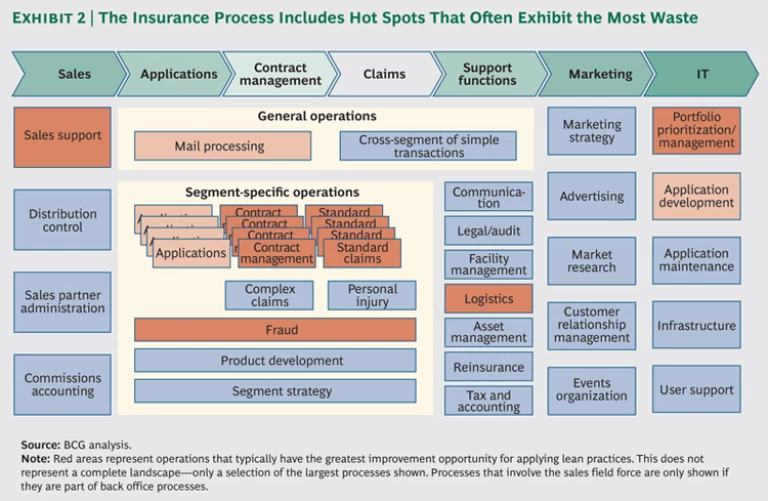Insurers know that lean processes make for satisfied customers, but many grapple with the basic challenge of how best to create them. The demands of insurance customers are increasing when it comes to speed of processing and quality of service, and the payoff from delivering on those demands is growing in kind, given how important positive customer experiences and recommendations are these days in winning new business. Simple and lean processes are not just a significant factor in cost competition but also the foundation for superior service quality and long-term customer retention.
The industry faces a number of specific challenges in attaining this ideal. Many processes involving sales, administrative work, and external partners have developed over long periods and have become correspondingly complex. At the same time, media usage habits now require new access channels, which need to be integrated without increasing complexity even further. The same goes for introducing new products and pricing or integrating company businesses by making acquisitions or merging. Ultimately, the continued cost pressure is forcing the entire industry to keep increasing efficiency just as demands for quality and service are growing.
It is therefore no surprise that almost all insurance companies have launched optimization programs under the heading of “lean” in recent years. But it is also little wonder that these efforts have achieved varying degrees of success. The fact is that many insurance companies are still spending a great deal more than necessary, and the costs are adding up as duplication of effort and reliance on manual processes cause mistakes and increase processing times. According to our analysis, this type of waste constitutes up to 30 percent of non-value-creating work and can climb as high as 80 percent in extreme cases. Waiting time typically consumes at least 95 percent of application processes. (See Exhibit 1.) In the case of property and casualty (nonmotor) policies, that equates to eight minutes of actual working time every six days. The shortcomings often stem from lack of scope and input. For instance, many companies elect to optimize single processes or departments. In very few cases do they evaluate and improve their processes on the basis of customer perspectives and with lean principles integrated throughout the organization.
Enter Lean 2.0, a modern take on the production efficiency philosophy that creates leaner, stronger, and more customer-oriented processes. Lean 2.0 establishes a way of looking at activities within the company so that waste can be identified where it occurs and improvements are integrated into everyday work to improve quality and the customer’s experience. With Lean 2.0, the customer may be an end consumer or the internal organization. What matters is that processes are viewed holistically, or “end to end.” (See “Five Practical Ideas for Your Lean 2.0 Program.”)
Five Practical Ideas for Your Lean 2.0 Program
Five factors are essential to the success of Lean 2.0 programs:
- Customer Orientation. Improvements should be seen from the customer’s perspective to ensure that the organization does not revert to its past practice of optimizing single processes or departments.
- Performance Tracking. A central contact point should monitor compliance with priorities and support sustained progress.
- Specific Targets. It must be clear what the program should achieve—both strategically and financially.
- Pragmatism. Not every problem needs to be addressed with a big solution; many little steps are often more successful in delivering long-term integration and savings.
- Skills Growth. Employees who acquire new skills or develop new competencies during the lean program should be recognized accordingly (for example, through certification) in order to create a network of lean “messengers” and foster a lean culture.
If Lean 2.0 is to be more than a buzzword for further management discipline—and if it is to yield greater customer and employee satisfaction on a sustainable basis—then insurers should actively consider what has worked for other companies on the road to becoming a lean company. Companies that have been successful in this respect have dutifully considered and answered four basic questions before setting the wheels in motion.
What are our objectives? “Less waste, more customer focus” is an understandable desire. But if you want to be successful with a Lean 2.0 program, you need specific and ambitious targets for an improved customer experience, higher employee involvement, and real economic benefits. Companies should compare their present standing with where they want to be positioned in the future, whether that’s next year or three to five years from now. Our experience has revealed that processes can be 15 to 30 percent more efficient in as few as 12 months and that most of these savings can be realized with little or no adjustments to IT infrastructure.
The targets of a Lean 2.0 program, however, must entail more than just mere process improvements. They need to include prospects for slimming down the business model, the organization structure, or the IT architecture. Programs without specifically defined financial, customer, and employee targets quickly lose momentum and run the risk of losing traction as time goes on.
In this context, assessing priorities and translating set targets into subtargets and project steps are tasks for management. Typical problems that insurers have battled with—for instance, deciding between quicker claims processing to increase customer satisfaction and making sure claims are valid in the first place—ultimately fall on management’s ability to get involved and make consistent decisions.
Where do we start? Nothing is as convincing as concrete results when it comes to establishing internal support for lean efforts. Pilot projects are a recommended way to demonstrate the advantages of a Lean 2.0 program and build momentum for further action. The processes picked for pilot treatment should cover multiple organizational units to demonstrate the overall effect of lean processes. They should also be highly relevant to the organization—meaning they exhibit high frequency and capacity, such as those supporting claims—and they should show the potential for savings barring any IT investment. While each pilot should be tailored to the company’s specific needs, there are typical “hot spots” of waste in insurance companies that are ripe targets for pilot programs. (See Exhibit 2.)
How can we reach the entire organization? After a successful pilot phase, the expansion of the Lean 2.0 program can begin—without shying away from “sacred cows.” Management must make clear decisions about which processes have high, medium, or low priority and should use benchmarks and expert opinions to identify processes that are especially in need of improvement. As the program expands, skills will be developed on the job—with employees acquiring know-how by actively working on projects—and shared and sharpened through training measures.
In the initial phase, a dedicated team should serve as a competence center, composed of lean experts from the pilot phase who have since returned to their respective units to apply their knowledge there. By rotating trained employees, Lean 2.0 approaches can spread throughout the company. Companies can further support these goals and underscore the importance of lean initiatives by making experience with lean programs a prerequisite for certain management positions. The goal is to gradually have the lean culture internalized in the company so that it is part of everyone’s daily routine.
How can we ensure that change is substantial? Ultimately, any Lean 2.0 program should pay for itself. For that to happen, organizations need certain prerequisites: a dynamic network of employees who have experience with lean, an infrastructure with appropriate tools and methods, and clearly articulated arguments from senior leaders for simplifying processes, effectively communicating management’s expectations of a Lean 2.0 program, and actively collaborating to implement changes. Lean leadership is about the continued involvement of the company’s top performers in the program—and about defining a framework for success so that progress can be monitored and can form the foundation of a comprehensive and continuous dialogue about quality and cost.
Lean 2.0 isn’t a onetime feat used to optimize processes for short-term successes. Rather, it seeks long-term transformation by recognizing that all activities that generate waste and do not add value only serve to weaken the company. Each and every employee shares responsibility for improvement by making problems visible and treating them at their root instead of simply allaying the symptoms. In the end, Lean 2.0 programs are successful when organizations show a willingness to rethink behavior on a fundamental level and, if necessary, effect a forward-thinking cultural change.








